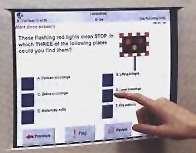Test Info
Fee Information
Below are the DVLA fees:
| Theory test | …… | £23.00 |
| Practical test | …… | £62.00 |
| Evening and Weekends | …… | £75.00 |
| Provisional licence | …… | £34.00 (£43.00 by post) |
 The theory test is made up of two parts; the multiple choice part and the hazard perception part. You need to pass both parts to pass the theory test. Once you have passed the theory test you can then apply to take your practical driving test.
The theory test is made up of two parts; the multiple choice part and the hazard perception part. You need to pass both parts to pass the theory test. Once you have passed the theory test you can then apply to take your practical driving test.
Taking your theory test
The multiple choice part is delivered using a touch screen computer and the hazard perception part records your responses through the use of a computer mouse button.
If you pass one part and fail the other you’ll fail the whole test, and you’ll need to take both parts again.
Part one – multiple choice
Before the test starts you’ll be given instructions on how the test works. You can also choose to go through a practice session of the multiple choice questions to get used to the layout of the test. At the end of the practice session the real test will begin.
A question and several answer options will appear on screen and you have to select the correct answer to the question by touching the screen. Some questions may require more than one answer.

You’ll be asked 50 questions in 57 minutes and the pass mark is 43 out of 50. You can navigate between questions and ‘flag’ questions that you want to come back to later in the test. After the multiple choice part you can choose to have a break of up to three minutes before the hazard perception part starts.
Part two – hazard perception
After the break you’ll then be shown a short tutorial video clip about how the hazard perception part works.
The hazard perception part is also delivered on a computer but you respond by clicking a button on the mouse. You’ll be presented with a series of 14 video clips which feature every day road scenes. In each clip there’ll be at least one developing hazard, but one of the clips will feature two developing hazards.
To achieve a high score you’ll need to respond to the developing hazard during the early part of its development. The maximum you can score on each hazard is five.
You won’t be able to review your answers to the hazard perception test; as on the road, you’ll only have one chance to respond to the developing hazard.
The pass mark for the car and motorcycle hazard perception part of the theory test is 44 out of 75.
New Driving Test Information
These are the changes, applicable from 4th December 2017:
The 4 driving test changes
1. Independent driving part of the test will increase to 20 minutes
The independent driving part of the test currently lasts around 10 minutes. During this part of the test, you have to drive without turn-by-turn directions from the driving examiner.
This part of the test will be made longer, so it’ll last around 20 minutes – roughly half of the test.
2. Following directions from a sat nav
During the independent driving part of the test, most candidates will be asked to follow directions from a sat nav.
The examiner will provide the sat nav (a TomTom Start 52) and set it up. You won’t need to set the route – the examiner will do this for you. So, it doesn’t matter what make or model of sat nav you practise with.
You can’t follow directions from your own sat nav during the test – you have to use the one supplied by the examiner.
You’ll be able to ask the examiner for confirmation of where you’re going if you’re not sure. It won’t matter if you go the wrong way unless you make a fault while doing it.
One in 5 driving tests won’t use a sat nav. You’ll need to follow traffic signs instead.
3. Reversing manoeuvres will be changed
The ‘reverse around a corner’ and ‘turn-in-the-road’ manoeuvres will no longer be tested, but you should still be taught them by your instructor.
You’ll be asked to do one of 3 possible reversing manoeuvres:
- parallel park at the side of the road
- park in a bay – either driving in and reversing out, or reversing in and driving out (the examiner will tell you which you have to do)
- pull up on the right-hand side of the road, reverse for 2 car lengths and rejoin the traffic
4. Answering a vehicle safety question while you’re driving
The examiner will ask you 2 vehicle safety questions during your driving test – these are known as the ‘show me, tell me’ questions.
You’ll be asked the:
- ‘tell me’ question (where you explain how you’d carry out a safety task) at the start of your test, before you start driving
- ‘show me’ question (where you show how you’d carry out a safety task) while you’re driving – for example, showing how to wash the windscreen using the car controls and wipers
d
Click this link to see details of what to expect with a new test:
https://www.gov.uk/government/news/driving-test-changes-4-december-2017


